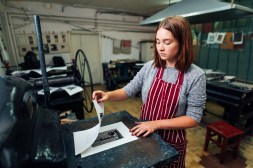The Future is Now: Discovering the Intersection of Art and Technology
In today’s fast-changing digital landscape, the intersection of art and technology has emerged as an exciting frontier. Artists are no longer confined to traditional mediums; they now have a wide range of digital tools available to create immersive and interactive experiences. This fusion of art and technology has unlocked new possibilities for creative expression, expanding the boundaries of what is possible in the art world. In this article, we will explore how technology has revolutionized the art world, highlight some groundbreaking examples, and consider the future implications of this exciting intersection.
I. Technology as a Medium: Expanding Horizons
Technology has become an integral part of artistic creation, enabling artists to experiment with new mediums and techniques. Digital platforms offer artists limitless possibilities for creating visual masterpieces that were once unimaginable. From digital painting to virtual reality installations, technology allows artists to explore uncharted territories and express their creativity in innovative ways.

One example is digital painting, which has gained immense popularity in recent years. Artists can use specialized software and tools to create stunning works of art on a digital canvas. This medium offers unique advantages such as unlimited color palettes, instant editing capabilities, and the ability to easily share artwork across various platforms.
Another groundbreaking medium that merges art and technology is virtual reality (VR). Artists can create immersive experiences that transport viewers into entirely new worlds. Through VR headsets, viewers can interact with art in ways never before possible. They can walk through virtual galleries or even become part of the artwork itself by manipulating objects or elements within the virtual space.
II. Interactive Installations: Engaging Audiences
The intersection of art and technology has also given rise to interactive installations that actively engage audiences in new ways. These installations blur the line between viewer and artwork, transforming passive observers into active participants.
One famous example is “Rain Room” by Random International—a large-scale installation that allows visitors to walk through a simulated rainstorm without getting wet. Sensors detect the presence of individuals and create a dry path for them to navigate through the falling rain. This interactive experience challenges the traditional notion of art as something to be observed from a distance, inviting viewers to become part of the artwork and actively shape their own experience.
III. Technology as Inspiration: Pushing Boundaries
Technology not only serves as a medium for artistic creation but also inspires artists to push boundaries and explore new concepts. The rapid advancement of technology has led artists to question traditional notions of art and explore themes such as artificial intelligence, data visualization, and the impact of technology on society.
One thought-provoking example is Trevor Paglen’s work on surveillance and privacy. Through photography, sculpture, and installations, Paglen sheds light on the hidden world of government surveillance systems. His artwork challenges viewers to consider the implications of living in a digitally connected society where privacy is increasingly eroded by technology.
IV. The Future Implications: Art in the Digital Age
As technology continues to evolve at an unprecedented pace, the intersection of art and technology will undoubtedly shape the future of artistic expression. With advancements like augmented reality (AR) and artificial intelligence (AI), artists will have even more tools at their disposal to create immersive experiences that blur the line between physical and digital worlds.
AR can overlay digital content onto real-world environments, allowing artists to create interactive art experiences accessible through smartphones or AR glasses. AI can generate unique artworks based on algorithms or assist artists in creating complex visualizations that would be impossible by human means alone.
In conclusion, the intersection of art and technology is transforming the way we perceive and engage with artistic expression. Artists now have access to an unprecedented range of tools and mediums that enable them to push boundaries, engage audiences in new ways, and explore previously uncharted territories. As we look towards the future, it is clear that this fusion of art and technology will continue to revolutionize the art world, offering new possibilities for creative expression and immersive experiences.
This text was generated using a large language model, and select text has been reviewed and moderated for purposes such as readability.


